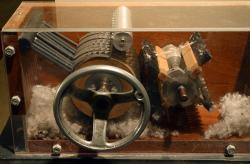
This Creative Development Which Was Responsible For The Survival Of The Cotton Industry In The United States Occurred In General Nathaniel Greene's Plantation Near Savannah 10 Miles Northeast Of This Marker. Separation By Hand Labor Of The Lint From The Seed Of The Desired Upland Variety Of Cotton Produced Only One Pound Per Day Per Person. Eli Whitney, A Native Of Massachusetts And Yale Law Graduate, Came To Georgia To Teach School In Late 1792, At Age 27. Mrs. Catherine Greene, Widow Of General Greene, Invited Whitney To Her Plantation, And Urged Him To Design A Cotton Gin. He Secluded Himself For 10 Days In The Spring Of 1793, With A Basket Of Cotton Bolls.
He Discovered That A Hooked Wire Could Pull The Lint Through A Slot In The Basket, Leaving The Seeds Inside. In His Patent Application Whitney Described The Process As: Consisting Of Spikes Driven Into A Wooden Cylinder And Having A Slotted Bar Through Which These Spikes Passed And Having A Brush To Clean The Spikes. The Result Was A Hand Operated Cotton Gin Which Produced Over 50 Pounds Per Person Per Day. It Was Patented March 14, 1794. Henry Ogden Holmes, Of Georgia, A Resourceful, Practical Mechanic On The Kincaide Plantation Of Fairfield County South Carolina, Invented An Improved Gin And Was Granted A Patent On May 12, 1796. His Continuous Flow Gin Used Rip-Saw Teeth On A Circular Steel Blade Which Passed Through Spaced Between Ribs. The Circular Saw Gin With Improvements, Capable Of Ginning 1000s Of Pounds Per Day, Was Still In Use In 1985. Officials Of The Cotton Exchange Commission Building, Which Faces This Marker, Shipped From The Port Of Savannah, Thousand Of Bales To A New Worldwide Industry, And Brought Prosperity To The South. Dedicated By The American Society Of Agricultural Engineers July 1986


